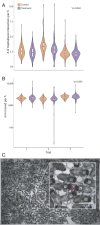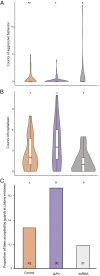Honey bee virus causes context-dependent changes in host social behavior
- PMID: 32341145
- PMCID: PMC7229666
- DOI: 10.1073/pnas.2002268117
Honey bee virus causes context-dependent changes in host social behavior
Abstract
Anthropogenic changes create evolutionarily novel environments that present opportunities for emerging diseases, potentially changing the balance between host and pathogen. Honey bees provide essential pollination services, but intensification and globalization of honey bee management has coincided with increased pathogen pressure, primarily due to a parasitic mite/virus complex. Here, we investigated how honey bee individual and group phenotypes are altered by a virus of concern, Israeli acute paralysis virus (IAPV). Using automated and manual behavioral monitoring of IAPV-inoculated individuals, we find evidence for pathogen manipulation of worker behavior by IAPV, and reveal that this effect depends on social context; that is, within versus between colony interactions. Experimental inoculation reduced social contacts between honey bee colony members, suggesting an adaptive host social immune response to diminish transmission. Parallel analyses with double-stranded RNA (dsRNA)-immunostimulated bees revealed these behaviors are part of a generalized social immune defensive response. Conversely, inoculated bees presented to groups of bees from other colonies experienced reduced aggression compared with dsRNA-immunostimulated bees, facilitating entry into susceptible colonies. This reduction was associated with a shift in cuticular hydrocarbons, the chemical signatures used by bees to discriminate colony members from intruders. These responses were specific to IAPV infection, suggestive of pathogen manipulation of the host. Emerging bee pathogens may thus shape host phenotypes to increase transmission, a strategy especially well-suited to the unnaturally high colony densities of modern apiculture. These findings demonstrate how anthropogenic changes could affect arms races between human-managed hosts and their pathogens to potentially affect global food security.
Keywords: honey bee; host–pathogen evolution; pathogen manipulation; virus.
Conflict of interest statement
The authors declare no competing interest.
Figures




Comment in
-
The viruses and the bees.Nat Rev Microbiol. 2020 Jul;18(7):362-363. doi: 10.1038/s41579-020-0384-1. Nat Rev Microbiol. 2020. PMID: 32404893 No abstract available.
References
-
- Daszak P., Cunningham A. A., Hyatt A. D., Anthropogenic environmental change and the emergence of infectious diseases in wildlife. Acta Trop. 78, 103–116 (2001). - PubMed
-
- Adamo S. A., Parasites: evolution’s neurobiologists. J. Exp. Biol. 216, 3–10 (2013). - PubMed
-
- Aubert A., Sickness and behaviour in animals: A motivational perspective. Neurosci. Biobehav. Rev. 23, 1029–1036 (1999). - PubMed
-
- Daberkow S., Korb P., Hoff F., Structure of the U.S. Beekeeping industry: 1982-2002. J. Econ. Entomol. 102, 868–886 (2009). - PubMed
Publication types
MeSH terms
Substances
Associated data
Grants and funding
LinkOut - more resources
Full Text Sources

